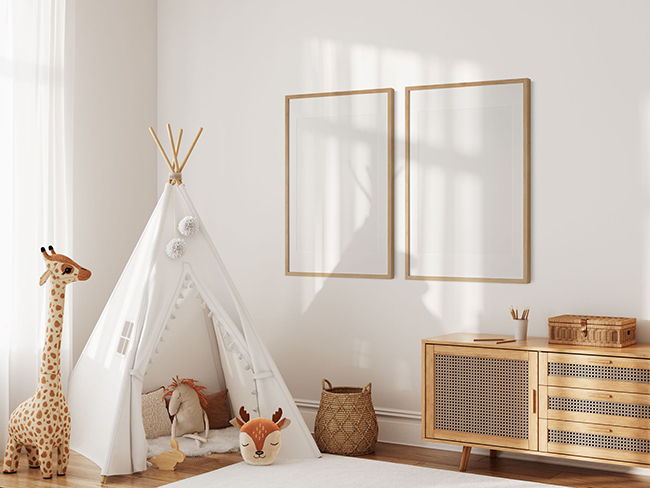A child’s bedroom is more than just a place to sleep; it’s a sanctuary for rest, a space for play, and a platform for self-expression. As a parent, creating the ideal bedroom for your kids is a journey filled with challenges and excitement. The goal is to design a room that caters to their ever-changing needs and promotes growth, safety, and comfort. With thoughtful planning and creativity, you can transform your child’s bedroom into a functional and nurturing haven they will love and cherish for years.

1. Space Utilization
Efficient use of space is crucial when designing a practical bedroom for your child. One approach to maximizing functionality is selecting multi-functional furniture, such as beds with built-in storage or desks that can also serve as play tables. Loft or bunk beds are excellent space-saving options, providing comfortable sleeping areas while leaving room below for play or study zones.
Incorporating various storage solutions is another essential aspect of space utilization. Consider using shelves, bins, and under-bed storage to organize toys, books, and clothing. This helps maintain a clean and orderly room. Use the vertical space by installing wall-mounted shelves or bookcases, allowing you to store items without sacrificing precious floor space.
Planning the layout of your child’s bedroom is equally important. Ensure enough space for play, study, and relaxation while keeping frequently used items easily accessible. Designate specific areas for different activities, such as a cozy reading corner or an arts and crafts station, to encourage your child’s engagement in a variety of pursuits. When considering the layout of your child’s bedroom, explore different styles of toddler beds to add a playful touch to the space. Whether opting for a themed bed or a convertible design, these choices not only contribute to a vibrant atmosphere but also cater to the evolving needs of your child. Designating areas for specific activities, alongside incorporating diverse styles of toddler beds, fosters an environment that stimulates creativity and enjoyment in various aspects of their daily routine.
2. Safety And Comfort
Your child’s safety and comfort is of utmost importance when designing their bedroom. By carefully selecting furniture and paying attention to various elements of the room, you can create a space that looks great and provides peace of mind.
A key factor in promoting comfort is choosing the right bed and mattress. Take the time to research different types of mattresses and their materials and read reviews from other parents. Buying a mattress online can offer a wide range of choices and the convenience of home delivery. However, check the return policy and any trial periods to ensure you’re satisfied with your purchase. A comfortable and supportive mattress can significantly impact your child’s sleep quality and overall well-being.
Furniture safety is another crucial aspect to consider. Opt for furniture with rounded corners and edges to minimize the risk of injury. Secure tall or heavy furniture pieces, such as bookcases or dressers, to the wall to prevent them from tipping over. When selecting window treatments, choose cordless options or those with safety features to reduce the risk of entanglement.
Lighting and temperature also play a vital role in creating a comfortable environment for your child. Provide ample natural light during the day and install blackout curtains or blinds to ensure a good night’s sleep. Choose energy-efficient LED lights for task lighting and consider adding a dimmable nightlight for added comfort. Make sure to maintain a consistent room temperature to keep your child comfortable.
3. Personalization
Personalizing your child’s bedroom is essential in fostering a sense of belonging and promoting self-expression. Involve your child in the design process, allowing them to choose colors, themes, or patterns that reflect their interests and personality. This collaborative approach helps create a space they will love and encourages creativity and decision-making skills.
To add a unique touch, display your child’s artwork or achievements on the walls, shelves, or bulletin boards. Incorporating these personal elements into the room’s design showcases their accomplishments and instills a sense of pride. Remember that your child’s tastes and preferences may evolve over time, so be prepared to update the room’s decor accordingly to maintain a space that truly reflects their individuality.

4. Flexibility For Growth
As your child grows and their needs change, it’s important to design a bedroom that can easily adapt to these transitions. This flexibility ensures that the room remains functional and appealing throughout the various stages of their development.
Select age-appropriate furniture that can accommodate their growth, such as adjustable-height desks or extendable beds. Incorporating adaptable furniture saves you time and resources in the long run, eliminating the need for frequent replacements.
Leave room for adjustments in the layout and design of the bedroom to cater to your child’s evolving interests and preferences. For instance, allocate space for a study area that can be transformed into a pleasant reading nook or a hobby station as their needs change.
Conclusion
Taking a practical approach to designing your child’s bedroom creates a space that supports their growth and development and fosters a sense of belonging and happiness. With thoughtful planning and adaptability, you can design a functional and comforting room, ensuring your child feels safe and nurtured in their personal sanctuary.
